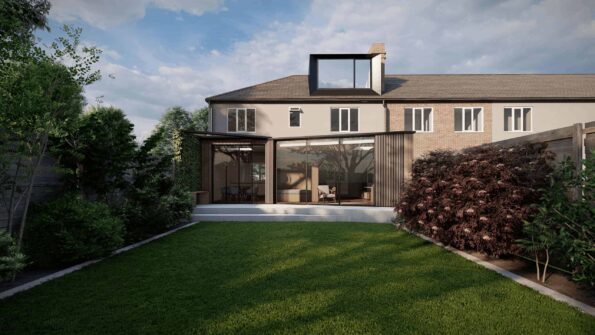Wraparound Extension UK 2025 | Costs, Planning, and Design Guide
5/22/20254 min read


Wraparound Extension UK 2025: A Complete Guide to Costs, Design & Planning
Looking to truly transform your living space? A wraparound extension could be the game-changer your UK home needs in 2025. This powerful combination of a rear and side return extension creates an L-shaped layout that unlocks maximum floor space and functionality.
In this blog, we’ll explore everything about wraparound house extensions in the UK — including design inspiration, costs, planning permission, building regulations, and why they’re worth considering in today’s housing market.
What is a Wraparound extension?
A wraparound extension merges a rear extension and a side return extension to form an L-shape around the back and side of your property. This design is particularly popular for Victorian and Edwardian terraced homes, where narrow kitchens and underused side alleys limit space.
By wrapping around your existing ground floor, you can create a large open-plan layout perfect for modern living — with space for a kitchen diner, living area, utility room, or even a home office.
Benefits of a Wraparound Extension
Choosing a wraparound extension offers several unique advantages:
Significantly increases internal space without moving house
Ideal for open-plan living — combine kitchen, dining, and lounge
Brings in natural light through skylights, roof glazing, or bi-fold doors
Improves property value and buyer appeal
Custom layout flexibility—tailor the flow to your lifestyle
Utilises underused side return areas efficiently
🏆 “A wraparound extension can add up to 20% to your property’s value, especially in London and major UK cities.” – UK Homebuilding & Renovating, 2025
How Much Does a Wraparound Extension Cost in the UK (2025)?
A wraparound extension costs more than a typical single rear extension due to its size, structural work, and planning complexity.
Here are current average costs in 2025:
Basic finish: £2,000–£2,500 per m²
Mid-range: £2,500–£3,000 per m²
High-end finish (London): £3,000–£3,500+ per m²
So, for a typical 25m² to 35m² wraparound extension, you’re looking at a ballpark figure of:
£60,000–£120,000, depending on quality, glazing, complexity, and location.
Also budget for:
Wraparound Extension Design Ideas for 2025
Want your new space to feel modern, seamless, and practical? Here are some top design trends for wraparound extensions in 2025:
Crittall-style glass doors and windows for an industrial vibe
Vaulted ceilings with skylights or roof lanterns
Polished concrete flooring with underfloor heating
Open-plan kitchen diner with island seating
Pocket doors or internal sliding walls to zone areas
Integrated garden spaces with level flooring from inside out
🌿 Sustainability Tip: Opt for energy-efficient glazing, eco insulation, and solar roof tiles to reduce your carbon footprint.
Do You Need Planning Permission for a Wraparound Extension?
In most cases, yes.
Unlike simple rear or side return extensions, wraparound extensions do not fall under Permitted Development Rights. That’s because they involve building on two different elevations and often exceed the size limits allowed under PD.
You'll usually need to submit a full planning application to your local council. The process takes 8–10 weeks and should include:
Full architectural drawings
Site location plan
Heritage statement (if in conservation area)
Design & access statement
For smoother approval, work with an experienced architect familiar with your local council’s policies. They can optimize the design to align with local planning guidelines.
What About Building Regulations?
Whether or not you need planning permission, all wraparound extensions must comply with UK Building Regulations. These ensure the safety and energy efficiency of your new structure.
Key areas that need approval:
Foundations and structural work
Load-bearing wall removal (often needed in wraparounds)
Roof structure and insulation
Glazing energy efficiency and safety
Fire safety and access
Drainage and ventilation
Electrics and plumbing (if installing a kitchen or bathroom)
A building inspector will visit at stages such as excavation, damp proofing, insulation, and final fit-out.
Challenges & Considerations
Before diving into a wraparound extension, keep these potential challenges in mind:
Complex structural changes may require steel beams (RSJs)
Natural light to middle rooms may be blocked unless designed cleverly
Drainage rerouting can add costs
Party wall agreements may be needed with neighbours
Garden size will be reduced, so consider layout balance
🔍 Always discuss your plans with your neighbors early—even if planning permission is not objected to, party wall agreements can delay construction.
Real-Life Wraparound Example (London)
A young family in Walthamstow converted their dark, narrow kitchen into a bright open-plan kitchen-diner with a utility room and snug.
Size: 32m²
Cost: £92,000
Timeline: 4.5 months
Features: Polished concrete floor, roof lantern, bespoke kitchen island
Result: Added value of £130,000 and huge lifestyle improvement
FAQs About Wraparound Extensions
How long does it take to build a wraparound extension?
Typically 12–16 weeks depending on scope and weather.
Can I live at home during the build?
Yes, but expect dust, noise, and partial disruption to kitchen or garden access.
Will it add value to my home?
Yes — wraparounds offer one of the highest ROI extensions in terms of floor space added and market value uplift.
Do I need a structural engineer?
Absolutely. Wraparounds usually involve significant structural work, especially when removing internal and external walls.
Final Thoughts
A wraparound extension is one of the most powerful ways to expand and future-proof your UK home. While it requires more planning and budget than smaller extensions, the return in space, comfort, and property value can be substantial.
Whether you're in London, Manchester, Bristol, or Leeds — a well-designed wraparound extension can elevate your home into a light-filled, modern living space that suits your lifestyle for years to come.